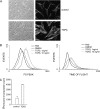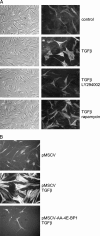Transforming growth factor-beta induces airway smooth muscle hypertrophy
- PMID: 16239645
- PMCID: PMC2644185
- DOI: 10.1165/rcmb.2005-0166OC
Transforming growth factor-beta induces airway smooth muscle hypertrophy
Abstract
Although smooth muscle hypertrophy is present in asthmatic airways, little is known about the biochemical pathways regulating airway smooth muscle protein synthesis, cell size, or accumulation of contractile apparatus proteins. We sought to develop a model of airway smooth muscle hypertrophy in primary cells using a physiologically relevant stimulus. We hypothesized that transforming growth factor (TGF)-beta induces hypertrophy in primary bronchial smooth muscle cells. Primary human bronchial smooth muscle cells isolated from unacceptable lung donor tissue were studied. Cells were seeded on uncoated plastic dishes at 50% confluence and TGF-beta was added. Experiments were performed in the absence of serum. TGF-beta increased cell size and total protein synthesis, expression of alpha-smooth muscle actin and smooth muscle myosin heavy chain, formation of actomyosin filaments, and cell shortening to acetylcholine. Further, TGF-beta increased airway smooth muscle alpha-actin synthesis in the presence of the transcriptional inhibitor actinomycin D, evidence that translational control is a physiologically important element of the observed hypertrophy. TGF-beta induced the phosphorylation of eukaryotic translation initiation factor-4E-binding protein, a signaling event specifically involved in translational control. Finally, two inhibitors of 4E-binding protein phosphorylation, the phosphoinositol 3-kinase inhibitor LY294002 and a phosphorylation site mutant of 4E-binding protein-1 that dominantly inhibits eukaryotic initiation factor-4E, each blocked TGF-beta-induced alpha-actin expression and cell enlargement. We conclude that TGF-beta induces hypertrophy of primary bronchial smooth muscle cells. Further, phosphorylation of 4E-binding protein is required for the observed hypertrophy.
Figures







References
-
- Ebina M, Takahashi T, Chiba T, Motomiya M. Cellular hypertrophy and hyperplasia of airway smooth muscles underlying bronchial asthma: a 3-D morphometric study. Am Rev Respir Dis 1993;148:720–726. - PubMed
-
- Benayoun L, Druilhe A, Dombret MC, Aubier M, Pretolani M. Airway structural alterations selectively associated with severe asthma. Am J Respir Crit Care Med 2003;167:1360–1368. - PubMed
-
- Woodruff PG, Dolganov GM, Ferrando RE, Donnelly S, Hays SR, Solberg OD, Carter R, Wong HH, Cadbury PS, Fahy JV. Hyperplasia of smooth muscle in mild to moderate asthma without changes in cell size or gene expression. Am J Respir Crit Care Med 2004;169:1001–1006. - PubMed
-
- Halayko AJ, Camoretti-Mercado B, Forsythe SM, Vieira JE, Mitchell RW, Wylam ME, Hershenson MB, Solway J. Divergent differentiation paths in airway smooth muscle culture: induction of functionally contractile myocytes. Am J Physiol Lung Cell Mol Physiol 1999;276:L197–L206. - PubMed
-
- Camoretti-Mercado B, Liu H, Halayko A, Forsythe S, Kyle J, Li B, Fu Y, McConville J, Kogut P, Vieira J, et al. Physiological control of smooth muscle-specific gene expression through regulated nuclear translocation of serum response factor. J Biol Chem 2000;275:30387–30393. - PubMed
Publication types
MeSH terms
Substances
Grants and funding
LinkOut - more resources
Full Text Sources
Research Materials

